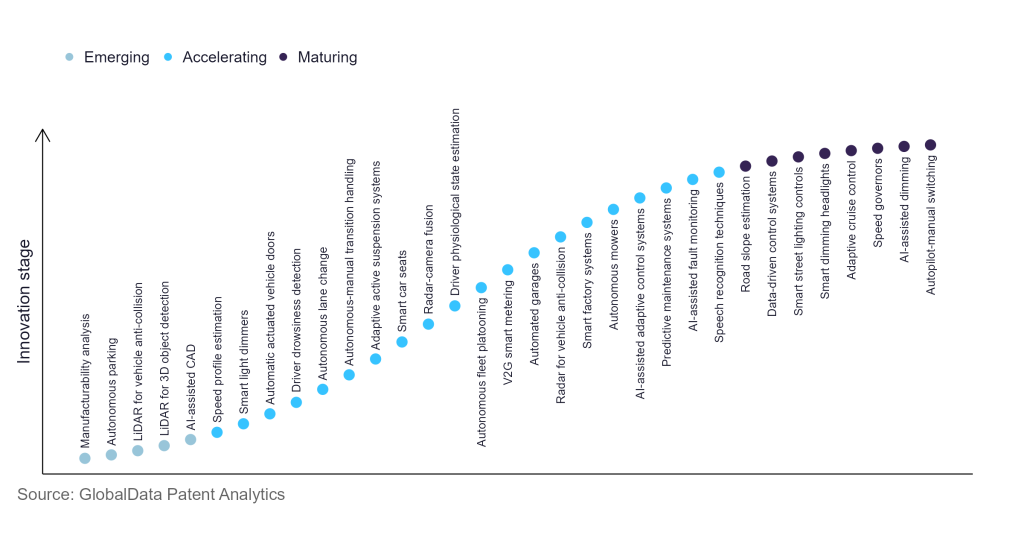The automotive industry continues to be a hotbed of innovation, with activity driven by factors such as comfort, safety etc, and growing importance of technologies such as artificial intelligence, machine learning, compact door actuators, and smart autonomous doors. In the last three years alone, there have been over 1.2 million patents filed and granted in the automotive industry, according to GlobalData’s report on Artificial intelligence in Automotive: Automatic actuated vehicle doors. Buy the report here.
However, not all innovations are equal and nor do they follow a constant upward trend. Instead, their evolution takes the form of an S-shaped curve that reflects their typical lifecycle from early emergence to accelerating adoption, before finally stabilising and reaching maturity.
Identifying where a particular innovation is on this journey, especially those that are in the emerging and accelerating stages, is essential for understanding their current level of adoption and the likely future trajectory and impact they will have.
290+ innovations will shape the automotive industry
According to GlobalData’s Technology Foresights, which plots the S-curve for the automotive industry using innovation intensity models built on over 619,000 patents, there are 290+ innovation areas that will shape the future of the industry.
Within the emerging innovation stage, manufacturability analysis, autonomous parking, and lidar for vehicle anti-collision are disruptive technologies that are in the early stages of application and should be tracked closely. Speed profile estimation, smart light dimmers, and driver drowsiness detection are some of the accelerating innovation areas, where adoption has been steadily increasing. Among maturing innovation areas are road slope estimation and adaptive cruise control, which are now well established in the industry.
Innovation S-curve for artificial intelligence in the automotive industry

Automatic actuated vehicle doors is a key innovation area in artificial intelligence
An automatic vehicle door opening and closing system allows the driver to open or close a preferred door on the vehicle without getting out of the driver's seat. It includes a controller with at least one button for each door.
GlobalData’s analysis also uncovers the companies at the forefront of each innovation area and assesses the potential reach and impact of their patenting activity across different applications and geographies. According to GlobalData, there are 40+ companies, spanning technology vendors, established automotive companies, and up-and-coming start-ups engaged in the development and application of automatic actuated vehicle doors.
Key players in automatic actuated vehicle doors – a disruptive innovation in the automotive industry
‘Application diversity’ measures the number of different applications identified for each relevant patent and broadly splits companies into either ‘niche’ or ‘diversified’ innovators.
‘Geographic reach’ refers to the number of different countries each relevant patent is registered in and reflects the breadth of geographic application intended, ranging from ‘global’ to ‘local’.
Patent volumes related to automatic actuated vehicle doors
Source: GlobalData Patent Analytics
Brose Fahrzeugteile is one of the leading patent filing companies in automatic actuated vehicle doors. It recently developed a new technology, the connected door and seat functions. Using this technology, the automobile detects the driver and opens the door automatically. The front seats' side bolsters are also lowered to make getting in and out of the car simpler. Other key patent filers in this area include Montagu Private Equity, Denso, Robert Bosch Stiftung, and MITSUBA.
To further understand how artificial intelligence is disrupting the automotive industry, access GlobalData’s latest thematic research report on Artificial Intelligence (AI) in Automotive.
Data Insights
From

The gold standard of business intelligence.
Blending expert knowledge with cutting-edge technology, GlobalData’s unrivalled proprietary data will enable you to decode what’s happening in your market. You can make better informed decisions and gain a future-proof advantage over your competitors.



